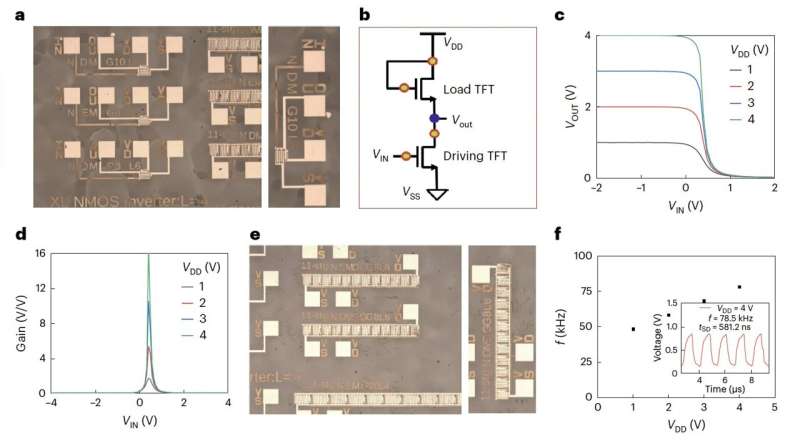June 2, 2024 feature
This article has been reviewed according to Science X's editorial process and policies. Editors have highlighted the following attributes while ensuring the content's credibility:
fact-checked
peer-reviewed publication
trusted source
proofread
Novel formamidinium lead iodide perovskite n-type transistors have notable field-effect mobilities

Metal halide perovskites, a class of crystalline materials with remarkable optoelectronic properties, have proven to be promising candidates for the development of cost-effective thin-film transistors. Recent studies have successfully used these materials, particularly tin (Sn) halide perovskites, to fabricate p-type transistors with field-effect hole mobilities (μh) of over 70 cm2 V−1 s−1.
So far, these notable field-effect mobilities have only been reported in p-type transistors, as perovskite channels based on tin are poorly suited to the development of n-type transistors. This hinders the development of complementary logic circuits, which would require both p-type and n-type transistors attaining similar performances.
To fill this gap in the literature, some teams have thus been exploring the potential of other metal halide perovskites for designing n-type thin-film transistors, particularly lead halide perovskites. Lead halide perovskites alone, however, exhibit ionic defects that significantly limit the resulting transistors' electron mobilities to around 3–4 cm2 V−1 s−1 .
Researchers at the National Centre for Scientific Research Demokritos, École Polytechnique Fédérale de Lausanne (EPFL), the Indian Institute of Technology and other institutes worldwide recently introduced a new strategy to develop better performing metal halide perovskite-based n-type transistors. This strategy, outlined in a paper in Nature Electronics, allowed them to fabricate n-type transistors with field-effect mobilities of up to 33 cm2 V−1 s−1, using formamidinium lead iodide (FAPbI3) perovskite.
"The engineering of tin halide perovskites has led to the development of p-type transistors with field-effect mobilities of over 70 cm2 V−1 s−1," Ravindra Naik Bukke, Olga A. Syzgantseva, and their colleagues wrote in their paper.
"However, due to their background hole doping, these perovskites are not suitable for n-type transistors. Ambipolar lead halide perovskites are potential candidates, but their defective nature limits electron mobilities to around 3–4 cm2 V−1 s−1, which makes the development of all-perovskite logic circuits challenging. We report formamidinium lead iodide perovskite n-type transistors with field-effect mobilities of up to 33 cm2 V−1 s−1 measured in continuous bias mode."
To boost the performance of their n-type transistors, the team used a methylammonium chloride (MACI) additive. This additive allowed them to regulate strain in FAPbI3, while also improving some of its properties.
"This is achieved through strain relaxation of the perovskite lattice using a methylammonium chloride additive, followed by suppression of undercoordinated lead through tetramethylammonium fluoride multidentate anchoring," the researchers wrote. "Our approach stabilizes the alpha phase, balances strain and improves surface morphology, crystallinity and orientation. It also enables low-defect perovskite–dielectric interfaces."
In initial tests, the n-type transistors designed by the team achieved highly promising results, including good electron mobilities, negligible hysteresis and a high operational stability when placed under negative and positive bias stress. The researchers have already used their transistors to fabricate two types of electronic components, namely all-perovskite unipolar inverters and 11-stage ring oscillators.
In the future, their proposed fabrication strategy could open new possibilities for the development of highly performing and cost-effective integrated circuits containing metal halide perovskite transistors. In addition, their n-type transistors could soon be tested further and integrated into other electronics.
More information: Ravindra Naik Bukke et al, Strain relaxation and multidentate anchoring in n-type perovskite transistors and logic circuits, Nature Electronics (2024). DOI: 10.1038/s41928-024-01165-5
© 2024 Science X Network





















